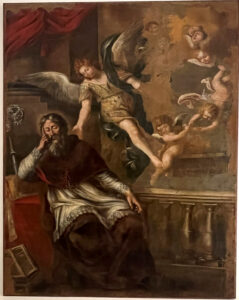Entrance Hall
The Entrance Hall is dedicated to the Dominican bishop Pietro Vincenzo Platamone, who in 1725 inaugurated the current bishop’s palace, profoundly renovated compared to the modest rooms used as an episcopal residence more than a century earlier.
The large room, from which the museum itinerary begins, introduces the visitor to the Christian religious history of Lipari through two canvases depicting the Archipelago’s patron saints, venerated since the dawn of Christianity and to whose vicissitudes are linked places, events, traditions and legends that have marked the history and culture of the Aeolian Islands.
The first painting, oil on canvas from the 18th century, depicts The Virgin Mary and the Patron Saints of Lipari interceding with the Trinity. Coming from the ancient altar of St. Calogero in the church of San Giuseppe in Lipari, the work reflects the faith and devotion of the islanders who saw the Virgin Mary and Saints Bartholomew, Calogero and Agathon as powerful intercessors and protectors especially against natural disasters, such as the frequent earthquakes of that period.
The second, larger altarpiece represents Bishop Saint Agathon receiving the announcement of the arrival of the body of the Apostle Saint Bartholomew. An oil on canvas that can be placed in a period between the 17th and 18th centuries, it comes from the ancient altar of Saint Agathon in Lipari Cathedral and represents the prodigious event that marks the beginning of Saint Bartholomew’s patronage of the Aeolian Islands.
A three-flight stone staircase leads from the entrance hall to the first floor where there are three rooms housing, respectively, 16th-century paintings and 17th- and 18th-century paintings from some of the island’s churches that no longer exist or are awaiting restoration.



